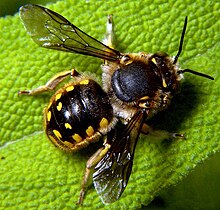Anthidium manicatum
| Anthidium manicatum | |
|---|---|
 |
|
| Scientific classification | |
| Kingdom: | Animalia |
| Phylum: | Arthropoda |
| Class: | Insecta |
| Order: | Hymenoptera |
| Family: | Megachilidae |
| Genus: | Anthidium |
| Species: | A. manicatum |
| Binomial name | |
|
Anthidium manicatum (Linnaeus, 1758) |
|
| Synonyms | |
|
|
|
Anthidium manicatum, commonly called the European wool carder bee, is a species of bee in the family Megachilidae, the leaf-cutter bees or mason bees.
They get the name 'carder' from their behaviour of scraping hair from leaves such as lamb's ears (Stachys byzantina). They carry this hair bundled beneath their bodies to be used as a nest lining. Like other members of the tribe Anthidiini, these bees do not cut leaves or petals as is typical for megachilids.
This bee is endemic to Europe, Asia and North Africa. It has recently been seen in regions of South America and the Canary islands. It was accidentally introduced into North America from Europe sometime in the mid 20th century. They are generalists, and do not seem to prefer any plant genera for foraging.
This species belongs to the family Megachilidae and the order Hymenoptera, which consists of organisms such as ants, bees and wasps, and the superfamily Apoidea, which is more specific to bees and wasps.
Anthidium manicatum is originally an Old World bee. It has a wingspan of approximately 20 millimetres (0.79 in), with a body length of about 11–13 mm (0.43–0.51 in) for females, and 14–17 mm (0.55–0.67 in) for males. The males are substantially larger than females.
A. manictum are black and covered with yellow-grey hairs. Their faces and abdomen are covered in yellow spots. Male A. manicatum have a black head and thorax, coated with short yellowish brown hairs. The cheeks below the antennae, a small spot behind each eye, a bilobate spot on the clypeus, and the mandibles (except the apex) are yellow. The wings are dusky in color. The abdomen is black with grey hairs, with a band of brown hairs at each segment’s apex as well as along their lateral margins. This feature distinguishes male A. manicatum from native Anthidium species. There is a yellow spot on each side of the segments except the 7th. A second pair of spots is often seen on the disks of the 4th and 5th segments. There is a spine on each side of the 6th and 7th segments at the apex, the 7th having a third thin spine in the middle. The legs exhibit variegation of yellow and are covered with grey hairs. Female A. manicatum are smaller in size than the males, but have a similar color pattern. The abdominal spots are smaller and the apex is rounded. Female legs are almost completely black, with very small yellow spots. The anterior sides of the tarsal segments of each leg of female A. manicatum have fine, soft and small white-colored hairs. This pilosity occurs in most species of Anthidium in the Western Palearctic region.
...
Wikipedia
